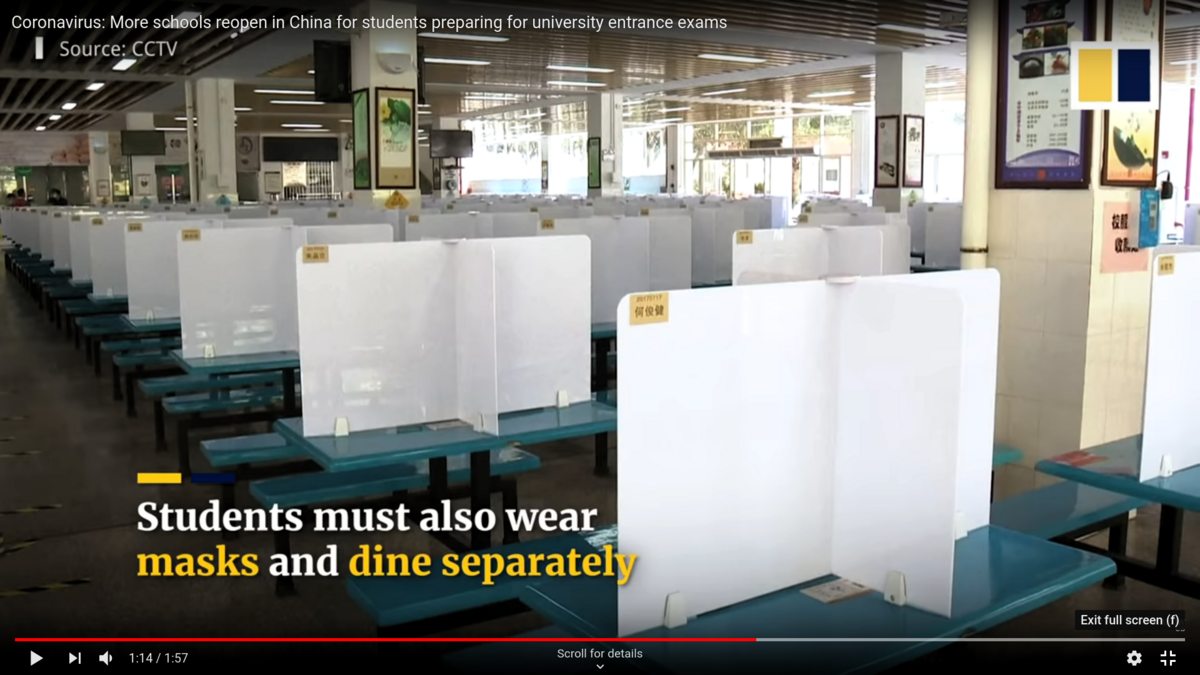
Agrandissement : Illustration 1

In the beginning of April, Wuhan factories that had been closed during the COVID-19 pandemic-related shutdown were reopened. Reportedly, high-level security measures have been introduced. Workers who enter a factory are being disinfected with highly concentrated alcohol, and they get their temperature measured. Workers’ temperatures are checked twice again during their shift. Inside the factory all workers must wear a mask and a special protection suit at all times. The places which workers used to use for social gatherings or potential encounters are closed – break rooms, conference rooms, smoking corners, etc. They are forced to ‘take food in’ at the work place itself, where each worker has her or his own table placed in security distance to other tables. An AFP image taken in a break room of a re-opened Honda factory in Wuhan powerfully captures the ‘social distancing’ logic of that labor environment. Weirdly enough, the situation depicted vaguely resembles the setting of a classroom. How do you read this image?
That’s an interesting observation, but I don’t necessarily share its underlying assumption. Spatially separating workers in the name of hygienic measures and in the interest of fighting the pandemic may resemble other forms of separation and prohibition (of assembly, of association, of labor politics, of “unruly” behavior at the workplace, etc.). However, I’d acknowledge that these measures bear a minimum of reasonability in light of the current situation. The pandemic at least complicates any criticism, justified as it may be, that falls back on venerable traditions of the analysis of power and discipline.
Sure, comparing the choreography of work depicted in the image of the Honda plant in Wuhan with images of separation and isolation of students in class is to some extent valid. Separate seating in classrooms has been a continuous feature in the history of education. Although distancing measures have been the subject of repeated contestation since the early days of reformist and progressivist pedagogy in the early twentieth century, they tend to be redeployed time and again. Against all the trends towards group work, team teaching and the unraveling of the disciplinary, geometric spatial orders of the classroom (which have always been reminders of the structural kinship among factory work, prison time, and formal education), the “egg crate” model of schooling has proven quite persistent.
Before you go deeper into the spatial politics of education, could you first expand your thoughts on the changing environment of labor?
In a sense, COVID-19 has forced industrial labor as well as the labor in “post-industrial” spaces to unlearn the lessons of the flexible workspace, of the “action office,” the “Bürolandschaft,” or the fake lounge libertinism of Facebook and Google headquarters. These models of creativity-/innovation-inducing environments all originated in the 1950s and 1960s when corporate culture, cybernetics, behavioral psychology, and ergonomics were combined to redefine the workspace, only to be supported in this effort soon thereafter by the ostensibly anti-authoritarian pop and countercultures of the period (much of this development has been chronicled in the television series Mad Men).
Authoritarianism never ceased, however, it just changed its terms. It cloaked itself in new forms and shapes, protocols and “philosophies” that were intended to signal freedom and laissez-faire. Capitalism has always been quite effective in dissimulating its violent and throbbing disciplinary force. What is happening now, under the manifold influences of virologists, epidemiologists, politicians, and industry, is a peeling away of such surfaces of openness and liberty, and a rediscovery of the barren structures upon which they have been grafted. However, the imposition of rules of distancing, of isolation and securitization due to COVID-19 comes face to face with different cultures of labor and education. Depending on the respective national and geographic context, the features of lockdown and prevention can appear more or less alien to those affected by it, and may thus be experienced as more or less exceptional.
Could you give an example?
The draconic regime of testing in China epitomized in the hellish, nationwide gaokao exam that determines college placement for high school seniors, has generated images (and – orientalizing – fantasies) of panic-ridden, drilled students being seated in large numbers in huge school halls or sometimes stadiums, an ornament of the (joyless) masses if there ever was one. The “super high schools” that prep students for this ordeal are aptly called “educational factories,” since they resemble the old assembly-line type of factory (a metaphor/analogy popular in the 1960s when Workerism, André Gorz, and others put it to productive conceptual and political use). It might be argued that the kind of discipline performed in the gaokao exam belongs to a larger scheme of authoritarian rule that is part of a culture of preparedness with regard to health crises of the scale of SARS epidemics, such as the first one in 2003 and the SARS-CoV-2 pandemic of 2019-20.
Unsurprisingly, scenes of ‘social distancing’ are becoming common in the world of education. In fact, in the COVID-19 pandemic the image of ‘a group of isolated individuals in one room’ was first shaped in classrooms in Taiwan, where responses to the spread of the corona virus were organized as early as late December 2019. Images of classrooms show pupils at individual desks that are enclosed by yellow plastic walls. Tellingly, Taiwan is not allowed to be a WHO member but hailed as the only country that was able to respond to the virus with an array of de facto preventive measures rather than just organizing ad hoc adaptations. Consequently, little criticism is voiced as regards the measures deployed themselves. First, where do you see parallels between the isolated pupils and the isolated workers?
The factory/school analogy is an ideal candidate to become the object of an in-depth study of its history, semantics, and use value. As intimated before, I am not entirely convinced whether this analogy actually helps better understand and conceptualize the specifics of the current situation. Health and hygienic issues have informed and driven the whole process of modernization, and they continue to inform every aspect of spatial politics – in urban planning, in the spatial regulations of factory and office labor (where health administrations, building departments and unions work hand in hand), and with regard to educational facilities.
Health, since it affects everyone, if to different degrees, is a universalizing and generalizing parameter of planning, and right now it is being prioritized more than is usually the case. Thus, the question whether practices of isolation (and images thereof) in workplaces and schools bespeak a continuum of discipline and control across these spaces of work is to be weighed carefully to avoid collapsing a standard critique of power, alienation, and abstraction (of labor, cognitive and physical) into a critique of anti-viral preventive measures. I am not saying, however, that the latter could not be used to foster the former.
In what sense are the school and the factory complementary institutions as far as ‘treating’ the threat of ‘unpredictable’ associations among group members?
During the past days I watched (again) the fourth season of the excellent television series The Wire. As fans of The Wire know well, that's the season that focuses on the school system of Baltimore, Maryland, a city with a majority Black population, in the mid-2000s. Narrating different stories of students, teachers, principals, and educationalists in a local, urban middle school in a near documentary fashion, the failure of the system to serve the needs of the pupils and the community as a whole is rendered palpable. The urgency of the issue of space and separation/segregation in education is persuasively articulated. The classroom is portrayed as a force field of contestation and confrontation.
However, depending on the teacher in charge and the students in the room, curricular and spatial measures can be taken to turn the classroom space into one of actual learning and collaboration. For this to happen though, a spatial separation of those pupils who don’t see any use in the curriculum offered by the system but have a vital interest in learning and honing the skills and the trade of the “corners,” of dealing drugs and surviving amid gang wars, proves to be helpful. “Useful knowledge” can be generated and acquired when the socio-spatial predicaments of learning are considered.
That said, to prevent “‘unpredictable’ associations” you sometimes have to come up with solutions that go beyond default (punitive) isolation. What this can possibly mean with regard to COVID-19-induced separations, I can’t tell. However, I’d be curious what David Simon (creator of The Wire, as well as The Corner, Treme, and The Deuce) would make of the current crisis in his writing on and of educational life-worlds.
One of the phenomena (and outright problems) of the current pandemic is that ‘we’ are ‘forced’ to avoid any potential exposure to contagion by pursuing isolated lives in online-only mode. The web is promoted as a contagion-free space. In the course of this, online learning is booming without any deeper inquiry into its tools, methods, and consequences, and the isolation of the individual is more or less taken for granted. To what extent is this about consolidating tendencies that aim to reduce the ‘human risk factor’ (including student strikes), and to what extent is this about preparing people for a braver new world of an even more frictionless capitalism?
Again, I’d be cautious with extrapolating too much and too quickly from the phenomenology of a situation that is still and arguably primarily to be considered one of health and care (with all the social, psychological, economic, ecological, etc. implications and repercussions coming with it). The whole system of video conferencing, remote teaching/learning, live streams, etc. wasn’t waiting for the ‘corona crisis’ to happen, but rather has been in the making for a long time. Earlier attempts at distance learning, tele-universities, etc. on a large scale date back to the 1960s and 1970s. It has always been the tech sector’s dream to do away with material spatialities and infrastructures, with physical and lived sociality.
The teleology of cybernetics is the virtualization of the material world, its translation into data. That’s a fact. And no doubt, the digital industries are benefitting enormously from the pandemic and the social distancing imperative, at least in the short run. For what has also become quite apparent in the course of only a few weeks – the promises of Zoom, Skype, Netflix, and the like can also turn stale and stultifying. They produce their own fatigues and boredoms, a dangerous dissatisfaction that Silicon Valley is no doubt busy developing a therapy for (in parallel to Big Pharma’s race for a corona vaccine and treatment).
In the 1960s the writings of Norbert Wiener and J. C. R. Licklider contributed to spread the word about Artificial Intelligence (AI) like wildfire at US universities, giving rise to the popular image of the ‘machinic superbrain’—even becoming a movie star in Stanley Kubrick’s “2001: A Space Odyssey” (1968). This AI hype catalyzed a transition during which capitalism as a self-reproducing, self-running, and ultimately ‘smart’ system was reinvented. In this period capital made a leap into a new, immaterial era—trained on the all-encompassing instrumentalization of labor, while designed to become entirely unaccountable to labor as well as labor struggles, e.g. in the form of worker (and student) revolts, but also resistance movements in (former) colonies. It was in this period that Buckminster Fuller, who is regarded as having understood AI and the Internet before they became mainstream, wrote in his book “Education Automation” (1962) about highly personalized forms and spaces of learning, mapping early versions of distance learning and remote teaching. What are the prehistories that you consider relevant in this context?
You are right in pointing out the reciprocities between cybernetics (and the [pre-]history of AI) and pedagogies that focus on the individual and thus aim at personalizing learning (as in the “child-centered” approach that is inherent in any “differentiated” curriculum and school type). Buckminster Fuller was not alone in calling for a radical overhaul of the education system in the 1960s. An entire generation of young architects, educationalists, countercultural types, etc., propagated a new spatial and design politics that was geared towards the learning self (see e.g. my “Spaces of the Learning Self”). Such imaginaries of extramural learning environments for the singularized learner who inhabits “capsules” and “study carrels” moved away from a new economy of scale in the rapidly expanding education systems of the post-war decades, that is: of what I propose to call the Education Shock.
It could be argued that the drive towards autonomous systems of (knowledge) production implicit in the development of AI has considerably informed the debates around schooling beyond the confines of the school building. As much as it is a networked technology, AI in its early days was imagined to be based on a central supercomputer rather than on a web of distributed data centers. The individualized learners were to be brain-fed by a single HAL-like machine.
Catering to the needs of the individual is an important objective of any advanced pedagogy; it needs to be counterbalanced, however, with the recognition of its social and environmental conditions. In the progressivist and countercultural discourses of the years around 1970, the individual learner was thus also always placed within a “community” or “tribe.” The computer was seen as a means to yield a “radical software,” and learning was conceived as an essentially liberating and emancipatory activity, to be held against the learning factories of capitalist education (and education for capitalism).
However, it must be emphasized that the individualist/tribalist visions of (Western) countercultures were typically oblivious of their own privileges and elitism. Inadvertently (or not), they disconnected from the world of labor and its struggles. Criticisim of the “machines” of the education industry – materializing in the huge education centers built for thousands of pupils or the university campus mega-structures mushrooming everywhere – was often also dismissive of the new educational “masses” generated (in the West) by welfare state educational policies and (in the East) by socialist measures of expanding access to learning and knowledge.
The real and substantial links between an expanding educational system geared towards producing workers for the new knowledge industries and class struggle became increasingly invisibilized. Technology, and cybernetics more specifically, certainly had its share in this development (though the particular historical role of cybernetics in the Communist countries needs to be considered here as well).
Designs of learning environments like those depicted on a photograph taken by Leon Kunstenaar in 1971 look conspicuously like computer-assisted work places. Here, the trope of ‘isolated individuals in a group context’ oscillates between the factory and the school, evoking hybrids such as ‘factories of education’ and ‘schools of work.’ It seems the isolated individual – his or her body and brain – successfully becomes the key site for the production and accumulation of ‘constant capital’ when the disciplinary discourses of working and learning are not just intermingled but also placed in a circular relation – what do you think?
The photograph of the hexagonal “learning laboratory” by Kunstenaar was made in an “experimental” school in the Boston area. The Wm. Monroe Trotter Elementary School in Roxbury, Mass. was opened around 1970 to be frequented mostly by Black children. One basic idea of the school’s design was to combine “open plan” group work with individualized learning stations such as the one depicted here. The circularity of this particular setting results from the hexagonal designs of large parts of the school. It was the exception rather than the rule in a time of predominantly container-shaped big schools. I’d thus be careful, once again, about drawing too neat an analogy between factory and school. Although, here I agree, the labor that is learning is the predicament around which even the most “progressive” architectural designs of the Education Shock age revolved.
Against this backdrop, the question arises how we can reconsider the politics of isolated learning as it is being reactivated and reinvented during the current pandemic.
Here’s an image similar to the one from Taiwan you mentioned, showing, as the caption states, “high school senior students study[ing] with plastic partitions in a classroom.” Taken at a Wuhan school in April 2020, the image resembles encounters in public that everyone has had in the past weeks – plastic partitions between cashier and customer. It’s an image of a world that has already been in a constant process of securitization for a very long time. Thousands of shops and offices around the world are familiar with the plastic shielding (often bullet-proof) that separates the customer (potential burglar) from the employee (system-relevant).
Job security and protection at the workplace are only two sides of an ever more rapidly swirling coin. The protected (care-)worker allegedly becomes the precondition of the system’s survivability. But what is a protected way of learning? A fenced schoolyard with a security guard on patrol? Certainly not. However, I tend to think of the classroom with plastic partitions as a potentially “safer” space than the domesticity of home schooling. Although around 1970 “free schools” were hailed as a Utopian alternative to the learning factories of the public school system, the home and the privacy of the family have always been potential harbingers of violence and abuse. Formal, public education may be flawed to the extreme, but it is also the only template on which an accountable and protected education is likely to happen. Home schooling and remote learning are not an alternative.
About SILENT WORKS
The SILENT WORKS project is dedicated to excavating forms of labor that are buried under present regimes of AI-driven capitalism. Find all details and up-to-date information on the SILENT WORKS project here: https://silentworks.info
About Tom Holert
Tom Holert works as an art historian, writer, curator and artist in Berlin. In 2015 he co-founded the Harun Farocki Institut in Berlin (HaFI), on the website of which he is currently editing “Mutual Aid,” an ongoing special issue of HaFI's online journal Rosa Mercedes. At BAK (Basis voor actuele Kunst), Utrecht, he curated “Learning Laboratories: Architecture, Instructional Technology, and the Social Production of Pedagogical Space Around 1970” in 2016-17. Together with Anselm Franke he conceptualized the exhibition “Neolithic Childhood: Art in a False Present, c. 1930” at HKW in 2018. Currently he is working on the research, publication and exhibition project “Education Shock. Learning, Politics and Architecture in the 1960s and 1970s” for HKW (the exhibition’s opening had to be postponed to January 2021 due to Covid-19). Publications include “Knowledge Beside Itself: Contemporary Art’s Epistemic Politics” (2020), “Marion von Osten: Once We Were Artists” (2017, ed. with Maria Hlavajova), “Troubling Research: Performing Knowledge in the Arts” (2014, with Johanna Schaffer et al.), and “Übergriffe. Zustände und Zuständigkeiten der Gegenwartskunst” (2014).



